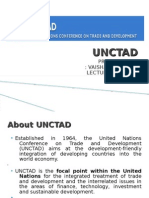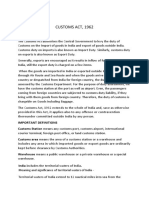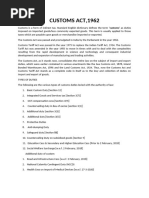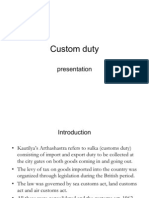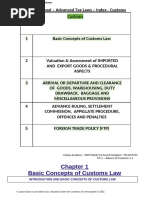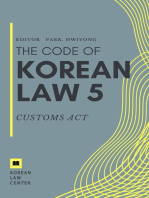0 ratings0% found this document useful (0 votes)
36 viewsUnit I - Customs Duty
Unit I - Customs Duty
Uploaded by
21ubha116 21ubha116Indirect Taxation
[1] Indirect tax is a tax levied on the consumption of goods and services that is ultimately passed on to the consumer. It differs from direct taxes which are directly imposed on individuals and entities based on income or wealth.
[2] In ancient times, merchants entering a kingdom had to pay a "gift" or tax to the king, which over time became formalized as a customs duty. Today, customs duty is collected by the Government of India from importers and exporters.
[3] The Customs Act of 1962 and Customs Tariff Act of 1975 govern customs law in India and specify classification of imported and exported goods and applicable duty rates. The objective is
Copyright:
© All Rights Reserved
Available Formats
Download as KEY, PDF, TXT or read online from Scribd
Unit I - Customs Duty
Unit I - Customs Duty
Uploaded by
21ubha116 21ubha1160 ratings0% found this document useful (0 votes)
36 views64 pagesIndirect Taxation
[1] Indirect tax is a tax levied on the consumption of goods and services that is ultimately passed on to the consumer. It differs from direct taxes which are directly imposed on individuals and entities based on income or wealth.
[2] In ancient times, merchants entering a kingdom had to pay a "gift" or tax to the king, which over time became formalized as a customs duty. Today, customs duty is collected by the Government of India from importers and exporters.
[3] The Customs Act of 1962 and Customs Tariff Act of 1975 govern customs law in India and specify classification of imported and exported goods and applicable duty rates. The objective is
Copyright
© © All Rights Reserved
Available Formats
KEY, PDF, TXT or read online from Scribd
Share this document
Did you find this document useful?
Is this content inappropriate?
Indirect Taxation
[1] Indirect tax is a tax levied on the consumption of goods and services that is ultimately passed on to the consumer. It differs from direct taxes which are directly imposed on individuals and entities based on income or wealth.
[2] In ancient times, merchants entering a kingdom had to pay a "gift" or tax to the king, which over time became formalized as a customs duty. Today, customs duty is collected by the Government of India from importers and exporters.
[3] The Customs Act of 1962 and Customs Tariff Act of 1975 govern customs law in India and specify classification of imported and exported goods and applicable duty rates. The objective is
Copyright:
© All Rights Reserved
Available Formats
Download as KEY, PDF, TXT or read online from Scribd
Download as key, pdf, or txt
0 ratings0% found this document useful (0 votes)
36 views64 pagesUnit I - Customs Duty
Unit I - Customs Duty
Uploaded by
21ubha116 21ubha116Indirect Taxation
[1] Indirect tax is a tax levied on the consumption of goods and services that is ultimately passed on to the consumer. It differs from direct taxes which are directly imposed on individuals and entities based on income or wealth.
[2] In ancient times, merchants entering a kingdom had to pay a "gift" or tax to the king, which over time became formalized as a customs duty. Today, customs duty is collected by the Government of India from importers and exporters.
[3] The Customs Act of 1962 and Customs Tariff Act of 1975 govern customs law in India and specify classification of imported and exported goods and applicable duty rates. The objective is
Copyright:
© All Rights Reserved
Available Formats
Download as KEY, PDF, TXT or read online from Scribd
Download as key, pdf, or txt
You are on page 1of 64
Indirect Taxation
A tax is a compulsory fee or financial
charge levied by a government on an
individual or an organisation to raise
revenue for public works.
Direct taxes in India refer to taxes that are
imposed directly on individuals and entities
based on their income or wealth.
Indirect tax is the tax levied on the consumption of
goods and services. It is not directly levied on the
income of a person. An indirect tax is passed off to
the consumer as part of the purchase price of a
good or service.
As per ancient custom, a merchant entering a
kingdom with his goods had to make a suitable gift
to the King. In the course of time, this ‘custom’ was
formalized into ‘Customs Duty’.
In modern times, this is collected by the GOI from
importers and exporters.
Two Acts which form part of Custom Law in India
The Customs Act 1962: Basic Act for Levy of
Custom Duty in India.
The Customs Tariff Act, 1975: Specifies the Rates
of Customs Duties.
Schedule 1: Classifications and rates of duties for
imports
Schedule 2: Classifications and rates of duties for
exports.
The Customs Act was formulated in the year 1962 to
prevent the illegal import and export of goods.
Moreover, all imported goods are subject to the duty to
protect indigenous industries as well as to keep the
imports to a minimum in the interests of Indian
companies and to secure the exchange rate of the
Indian currency.
Objects of the Customs Act, 1962
The Act extends to the whole of India.
i) To regulate imports and exports a) to decrease the imports into
India and to save foreign exchange reserves b) to protect the Indian
Industry from world competition.
ii) Source of revenue to the Central Government
iii) To protect the Indian Industry from dumping
iv) Provisions of Customs Acts are used for other acts like Foreign
Trade (Development and Regulation) Act, FEMA (Foreign
Exchange Management Act), etc.
Features of Custom Duties / Circumstances of Levy of
Duties
1. Taxable event
2. Territorial waters of India
3. Indian custom waters
4. Goods under Custom Act – u/s 2(22)
5. Government’s liability to pay Custom Duties
6. Custom Duty a Union Subject.
1. Taxable Event
Exports u/s 2 (18) – The taxable event for exports is
when goods cross the custom frontiers of India.
Imports u/s 2 (23) – The taxable event for imports
is when goods enter the custom frontiers of India.
2. Territorial Waters of India:
Goods entering or going outside the limits of territorial
water of India shall be chargeable to Customs duty.
Section 3 of “Territorial Waters, Continental Shelf,
Exclusive Economic Zone and other Maritime Zone
Act, 1976.”
Territorial waters extend upto 12 Nautical miles from the
Base Line on the Coast of India and include any bay,
gulf, harbour, creek or tidal river.
1 Nautical Mile = 1.1515 miles = 1.853 kms
3. Indian Customs Waters:
The Indian Customs Waters extends upto 12 nautical
miles beyond the territorial waters.
First 12 NM = Territorial waters of India
Next 12 NM = Contiguous waters of India
Therefore, total 24 NM from the baseline on the coast
of India including any bay, gulf, harbour, creek, or tidal
river is called as Indian Customs Waters.
Significance of Custom Waters:
i) Custom officer can arrest a person in India within
Custom Waters (Section 104).
ii) Custom officer can stop and search a vessel within
Custom Waters (Section 106).
iii) A vessel which is within Indian Custom Waters can be
confiscated which is constructed or fitted in any matter
for the purpose of concealing goods. [Section 115 (1) (a)]
iv) A Customs officer has the authority to search any
person on board a vessel in Customs waters if there's a
reasonable belief that the person is hiding goods that can
be confiscated. [Section 100 (2) (a)].
v) Any goods brought into Customs waters in violation of
import prohibitions are subject to confiscation, as
specified in Section 11 (d).
4. Goods under Custom Act – u/s 2 (22) goods includes:
i) Vessel, Aircraft, Vehicles
ii) Stores (spare parts)
iii) Baggage (Commercial)
iv) Negotiable Instruments and Currency
v) Any other movable property
The criteria is that the goods must be movable and marketable.
Dutiable Goods: U/s 2 (14) Any goods which are chargeable to
duty and on which duty has not been paid are termed as dutiable
goods.
NonDutiable goods: If the rate of duty on goods is “free” i.e. no
Duty is payable, then such goods are called as nondutiable
goods. Even if such goods are brought as baggage, no Custom
Duty is payable on such goods.
Section 21 of the Customs Act,1962 Goods Derelict,
Goods Jetsam, Goods Flotsam and Wreckage are
treated as imported goods even though they do not
come from a proper channel.
Hence they are liable to Customs Duty.
5. Government’s liability to pay Custom Duties
There is no general exemption to goods imported by the
Government.
However, various exemption notifications have been issued
and imports by the Indian Navy, specific equipment
required by the Police, Ministry of Defence, Coastal Guard
etc. are fully exempt from Customs Duty.
6. Custom Duty is a Union Subject:
Entry 83 to List I – (Union List) of Seventh Schedule to the
Constitution reads “Duties of Custom including export
duties”.
Therefore, export and import Duty is a union subject and
the power to levy is derived from the Constitution of India.
Power to levy Custom Duties and rate of Customs Duties
The power to levy Custom duties is a Union subject and is
derived from the Constitution of India.
Duties of Custom including export duties is mentioned in
Entry 83 to List I (Union List) of the Seventh Schedule to the
Constitution of India.
Section 12 of the Custom Act, 1962 – Charging Section,
provides that duties of Customs shall be levied at such rates as
are specified under the Customs Tariff Act, 1975 or any other
law for the time being in force on goods imported into or
exported from India.
Procedure for Assessment and Collection of Duties
A. Procedure followed by the Carrier
1. Arrival at Custom Port/Airport
2. Import General Manifest (IGM)
3. Grant of Entry Inwards
4. Unloading
5. Goods in the Custody of Port Trust Authorities
A "carrier" refers to the entity or individual responsible for
the physical transportation of goods from one location to
another. Carriers play a crucial role in the logistics and
supply chain process. They are involved in the movement of
goods across borders and are responsible for ensuring that
the goods reach their destination safely and in compliance
with relevant regulations.
1. Arrival at Custom Port/Airport – U/s 29 , the vessel or aircraft
can only land at the Custom port or Custom Airport. If arriving by
Land, the vehicle should come by the ‘Land Custom Station’ only.
2. Import General Manifest (IGM) – The Import General Manifest
(IGM) is a legal document that contains details about the cargo
arriving at a destination. The master of the vessel or the aircraft,
shall submit the IGM to the Customs Authorities.
The Import General Manifest (IGM) is a mandatory requirement
under Section 30 of the Customs Act 1962.
The IGM helps to ensure that all the import cargo carried by a vessel
has been reported, the carrier has followed all statutory
requirements, and that all the ship is carrying all required and
complete documents for import.
Similar to IGM, an Import Report is filed for imports entering the
country via land.
This form must be filled out completely and submitted to the
customs authority by the company handling the transport.Typically,
the IGM needs to be submitted 24 hours after the cargo arrives at the
destination port. The IGM may be submitted by the importer even
before the shipment gets to the port.
3. Grant of Entry Inwards:
After the IGM is duly submitted by the master of the carrier,
the documents are checked by the Customs officers. Such
entry inwards is granted only when the berthing
accommodation is granted to the vessel.
If the Customs Officer is satisfied after scrutinizing the
documents, the ‘Entry Inwards’ is granted to the vessel u/s
31.
4. Unloading:
U/s 32, the goods which are mentioned in the IGM are
permitted to be unloaded and handed over to the Port
Trust Authorities. Such unloading can be done only at
the approved place u/s 32 and under the supervision of
the Customs Officer u/s 34.
5. Goods in the Custody of the Port Trust Authorities:
U/s 45 of the Customs Act, the unloaded goods should stay in
the custody of the Port Trust Authorities until they are cleared
on payment of duty. The authorities must keep proper record
of the goods and not allow removal of the goods from the
Customs Area without the written permission from the
Customs officer.
Procedure for Assessment and Collection of Duties
B. Procedure followed by the Importer
1. Presentation of Bill of Entry (u/s 46)
2. Submission of Documents by Importer
3. Self assessment of Custom Duty
4. Verification/Appraisal by Proper Officer
5. Authorization from other Acts
6. Collection of Duty by Customs Authorities
7. Passed out of Custom charges
8. Delivery of Cargo
1.Presentation of Bill of Entry (u/s 46)
Bill of entry – document giving all details about goods to be
imported.
Has to be submitted by every importer in quadruplicate
B/E can be used both when goods are cleared for home
consumption and when cleared for depositing the goods in the
warehouse.
This document is useful for valuation and classification of
imported goods as the Customs duties as existing on the date
when the B/E is submitted by the importer are applicable.
A brief view of Features of B/E are:
a) Gives details about goods imported.
b) Important for valuation and classification of goods.
c) Prepared in quadruplicate
d) Standard size 16” X 13”. For computerization
purposes 15” X 12”.
Bill of entry for Home Consumption:
i) When the importer is ready to make the full payment of duties and take
away the goods, this kind of B/E is used.
Home consumption means “Use of goods within India”.
Bill of entry for Warehousing:
ii) When the goods are not cleared from the port but the importer intends to
store the goods in the warehouse without payment of duty, then such B/E is
used.
A.k.a – “Into Bond Bill of Entry” because a bond has to be executed for
deposit of goods in the warehouse.
B/E for ExBond clearance:
When the importer pays the duties and clears the goods from
warehouse, then the importer needs to get the bond cancelled
[bond which the importer executed while taking permission to
deposit the goods in the warehouse].
For cancelling that bond and taking the delivery of goods,
ExBond B/E is furnished by the importer.
Particulars mentioned in B/E:
i) Name and address of importer
ii) Name of ship
iii) Packages
iv) Marks – Serial Numbers / QR Codes
v) Quantity
vi) Value
vii) Description of goods
viii) Name of country where the goods have been imported
ix) Customs duty payable
2. Submission of documents by Importer:
As per the provisions of “Custom Manual on Self Assessment, 2011”, the importer has to submit
the following documents for determining the value and classification of goods.
Invoice
Packing List
Bill of Lading/ Delivery Order
GATT Declaration form (duly filled in)
Import License Copy
Letter of Credit
Insurance Policy
Certificate of country of origin
A declaration in prescribed form about correctness of all information.
3. Self Assessment of Custom Duty:
The self assessment of Custom Duty has been introduced w.e.f 8th April 2011. The
importer shall assess the Duty leviable on the goods imported on his own as per the
Self Assessment System.
4. Verification / Appraisal by Proper Officer: U/s 17(2) of the Customs Act, 1962,
after the importer does the self assessment of Duty leviable on imported goods, the
“Proper officer” shall verify the self assessment w.e.f. 8th April 2011.
The officer shall determine:
i) Valuation of goods imported
ii) Classification of goods
5. Authorization from other Acts:
The Customs authorities must verify whether the imports are
authorized under other Acts. The importer must have the IEC
(Importer Exporter Code). IEC is a mandatory unique 10 digit
alphanumeric code for import and export from India issued by
the DGFT (Director General of Foreign Trade), Department of
Commerce, Government of India.
6. Collection of Duty by Custom Authorities:
a) Where the duties are paid and goods are removed for home
consumption: Importer pays duty and takes delivery of goods.
b) When goods are deposited into the warehouse: No duty is paid by the
importer. Only a Bond is executed.
c) When goods are removed from the warehouse: When the importer
comes to take the delivery of goods from the warehouse, he pays the
duties on goods, warehouse charges and any other fee, then gets the bond
cancelled and takes delivery of goods.
7. Passed out of Custom charges: When the importer pays the
Customs duties leviable on his imported goods, the Customs
officer shall issue “Out of Custom charge” order u/s 47 of the
Customs Act after which the goods can be removed from the
custom area.
8. Delivery of cargo:
The importer can take delivery of cargo by showing the goods
have “Passed out of Customs charges”.
Exemptions from Duties
Section 25 of the Custom Act
If the Central Government is satisfied that it is necessary in
the public interest it may, by notification or by a special
order exempt, before or after clearance, the goods of any
specified description from the whole or any part of duty of
customs leviable thereon.
General Exemptions under Custom Notifications
1. Imports by privileged persons and organizations –
UN agencies, Governors, Vice President of India,
specified equipment by foreign news agency, personal
effects of deceased persons, gifts imported by CARE
(Cooperative for Assistance and Relief Everywhere).
2. Government imports – There is no general exemption to goods imported
by the Government u/s 12(2).
However, various exemption notifications have been issued and imports by
the Indian Navy, specific equipment required by the Police, Ministry of
Defence, Coastal Guard etc. are fully exempt from Customs Duty.
3. Import for training research and educational purposes – scientific
instruments, computer software, research material, prerecorded cassettes,
video tapes, films, etc. by noncommercial research organizations.
4. Imports for oil exploration, exhibitions, expeditions
etc.
Goods for mountaineering expeditions, displays at fairs,
archaeological exhibitions.
Raw materials imported to manufacture goods to send to
the UNO, projects financed by the World Bank, IBRD,
Asia Development Bank, USAID, ONGC.
5. Imports for handicapped, welfare institutions
– Goods imported for relief under agreement with
foreign government, apparatus for the blind and
deaf, specified goods for handicapped and disabled
persons.
6. Donations and gifts – Donations to the
government for use of defence personnel, gifts for
promoting art/culture, food from a UN approved
agency, gifts to ministers, public servants and
foreign dignitaries, donations to the National
Defence fund.
7. Sports goods, prizes, medals and trophies –
Challenge cups and trophies, medals awarded to the
Indian team, goods imported for the manufacture of
sports goods, sports goods imported by specified
authorities, specified sports foods by renowned
players.
8. Commercial samples and prototype goods – Exempt up
to a certain limit.
9. Import for repairs, reconditioning etc. – Goods can be
imported for repairs, reconditioning or reengineering. Has to
be in a bonded warehouse under Customs bond. Have to be
reexported within 3 years of import.
10. Medicine and drugs – Specified life saving drugs, equipment for family
planning operation, hospital equipment by government hospitals etc.
11. Import for display or use at fair, exhibitions – For demonstration
purpose is duty free under Notification No. 3/89 Cus. dated 9.1.1989. Should
be approved by authorized officer. If the exhibition is not approved then full
duty should be paid at the time of imports and drawback can be claimed at the
time of reexport of goods.
12. Import from SAARC countries – Goods imported from SAARC
countries are eligible for concessional rate of customs duty.
Duty Drawback
As per rule 2 (a) of Customs, Central Excise Duties and Service Tax Drawback rules,
1995 :
“Drawback in relation to any goods manufactured in India and exported, means the
rebate of duty or tax (as the case may be) chargeable on any imported material or
excisable materials used or taxable services used as input services in manufacture of
such goods.”
It is the refund of Duty of Customs and Central Excise that are chargeable on
imported and indigenous goods used in the manufacture of exported goods.
Section 74 – Duty Drawback on Re-Export
U/s 74 – Drawback is available for goods originally being imported
after paying duties and thereafter are being re-exported either in the
same form of after usage.
1. Goods imported and subsequently exported WITHOUT
usage –
Reasons : Import for exhibition, goods rejected, wrong shipment of
goods.
Duty Drawback allowed = 98% of Import Duty paid
2. Goods imported and subsequently exported AFTER usage
*From the date of clearance of goods for home consumption and the date when goods
are placed under Customs control for exports.
You might also like
- Introduction To Language 10th Edition Fromkin Solutions ManualDocument9 pagesIntroduction To Language 10th Edition Fromkin Solutions Manualxasuhymu25% (16)
- Co Kim Chan V Valdez Tan Keh DIGESTDocument3 pagesCo Kim Chan V Valdez Tan Keh DIGESTAids100% (11)
- The Shipbroker’s Working Knowledge: Dry Cargo Chartering in PracticeFrom EverandThe Shipbroker’s Working Knowledge: Dry Cargo Chartering in PracticeRating: 5 out of 5 stars5/5 (1)
- Nightjohn Reading GuideDocument5 pagesNightjohn Reading Guideapi-392404081No ratings yet
- UNCTADDocument13 pagesUNCTADKartik100% (1)
- EIDT Unit 4Document12 pagesEIDT Unit 4Samarth SahuNo ratings yet
- Chapter 20 Basic Concepts of Customs LawDocument19 pagesChapter 20 Basic Concepts of Customs LawMitanshi KhannaNo ratings yet
- Origin of Customs DutyDocument45 pagesOrigin of Customs DutyJayagokul SaravananNo ratings yet
- Customs Act Notes For CS ExecutiveDocument18 pagesCustoms Act Notes For CS ExecutiveVenkatesh PrabhuNo ratings yet
- Customs Manual 2012Document8 pagesCustoms Manual 2012SameerLalakiyaNo ratings yet
- Customs Notes (Introduction and Types of Duty PDFDocument16 pagesCustoms Notes (Introduction and Types of Duty PDFJayshree ShettiNo ratings yet
- CAIL - Unit 5 - Taxation LawDocument36 pagesCAIL - Unit 5 - Taxation Lawdeekshasureshreddy24No ratings yet
- Customs Regulations Export Import Procedures SEZ FTP 2014Document287 pagesCustoms Regulations Export Import Procedures SEZ FTP 2014chetanpatelhNo ratings yet
- Concept Book CMA CustomsDocument114 pagesConcept Book CMA Customssanthoshkasani9No ratings yet
- IGM FilingDocument23 pagesIGM FilingHANISH N KNo ratings yet
- Chapter 12 - Customs Act 1962Document6 pagesChapter 12 - Customs Act 1962Abhay Sharma100% (1)
- Customs Act 4Document12 pagesCustoms Act 4Sheetal SaylekarNo ratings yet
- Customs Word DocumentDocument4 pagesCustoms Word DocumentcoursesforsarangNo ratings yet
- Introduction To Customs DutyDocument34 pagesIntroduction To Customs DutyKunal Thakor67% (3)
- Customs, Excise and GST Full MaterialDocument55 pagesCustoms, Excise and GST Full MaterialramNo ratings yet
- 333Document55 pages333shree varanaNo ratings yet
- Procedure For Clearance of Imported and Export GoodsDocument74 pagesProcedure For Clearance of Imported and Export GoodsA. Gaffar ShaikNo ratings yet
- Kinds of InsuranceDocument24 pagesKinds of InsuranceanujNo ratings yet
- Study Notes (1-100)Document113 pagesStudy Notes (1-100)Nimra JamilNo ratings yet
- CMA Inter - Customs Notes @cmaportalDocument50 pagesCMA Inter - Customs Notes @cmaportalDilip Kumar100% (1)
- VSF UEq JQZXQ PRG ECVr Iohpu X4 A ZTTBo 7 ZIq DJ U9 BF 0Document42 pagesVSF UEq JQZXQ PRG ECVr Iohpu X4 A ZTTBo 7 ZIq DJ U9 BF 0Nikhil PahariaNo ratings yet
- Customs Act, 1962Document3 pagesCustoms Act, 1962Sheetal SaylekarNo ratings yet
- CA Final Idt Customs and FtpDocument161 pagesCA Final Idt Customs and FtpMANISHNo ratings yet
- 13 - Tax Law - Customs Law - 271219Document25 pages13 - Tax Law - Customs Law - 271219Sushil BansalNo ratings yet
- Customs Act, 1962Document40 pagesCustoms Act, 1962Mainak ChandraNo ratings yet
- Presented By: Abhishek Shah and Siddharth TrivediDocument20 pagesPresented By: Abhishek Shah and Siddharth TrivediSiddharthNo ratings yet
- Customs IntroductionDocument19 pagesCustoms IntroductionanshuNo ratings yet
- Taxation Unit 5Document35 pagesTaxation Unit 5GITANJALI MISHRANo ratings yet
- Customs Duty Lecture 1Document4 pagesCustoms Duty Lecture 1Ankit RajNo ratings yet
- 18913sm Finalnew Idtl Customs cp7Document44 pages18913sm Finalnew Idtl Customs cp7Japjyot singhNo ratings yet
- Circular 16 of 2012Document3 pagesCircular 16 of 2012AK SNo ratings yet
- Exim ManualDocument110 pagesExim ManualShubham ShuklaNo ratings yet
- Shail Sir ProjectDocument16 pagesShail Sir ProjectPreeti singhNo ratings yet
- Import Procedures & DocumentationDocument20 pagesImport Procedures & DocumentationM HarikrishnanNo ratings yet
- CustomDocument18 pagesCustomavinishNo ratings yet
- Chap1 - Unit 1 (Definitions) RIDDHI BAGMAR CA FINALDocument5 pagesChap1 - Unit 1 (Definitions) RIDDHI BAGMAR CA FINALniravNo ratings yet
- Custom DutyDocument14 pagesCustom Dutysatyam.diffNo ratings yet
- Assignment PDFDocument16 pagesAssignment PDFअभिशील राजेश जायसवालNo ratings yet
- HHDocument13 pagesHHLaxminarayanNo ratings yet
- Customs Act 1962 PART IDocument8 pagesCustoms Act 1962 PART IArti GNo ratings yet
- Overview of Import Procedure (1) 1Document78 pagesOverview of Import Procedure (1) 1pavan kumar gothwalNo ratings yet
- Appraising Manual: # Import DepartmentDocument7 pagesAppraising Manual: # Import DepartmentJeyakar PrabakarNo ratings yet
- Custom DutyDocument40 pagesCustom DutyVijayasarathi VenugopalNo ratings yet
- Assessment: (Sec 2 (2) )Document18 pagesAssessment: (Sec 2 (2) )poojabhagatNo ratings yet
- Territorial Waters of IndiaDocument1 pageTerritorial Waters of IndiaWelcome 1995No ratings yet
- Custom Shipping and Insurance SADocument11 pagesCustom Shipping and Insurance SAdeepak kumarNo ratings yet
- Custom ActDocument8 pagesCustom ActvijayxkumarNo ratings yet
- Procedures For ImportDocument12 pagesProcedures For ImportRodeoKenanNo ratings yet
- Importation, Exportation and Transportation of Goods: After Studying This Chapter, You Would Be Able ToDocument78 pagesImportation, Exportation and Transportation of Goods: After Studying This Chapter, You Would Be Able ToAbhishek SrivastavaNo ratings yet
- Custom 4Document80 pagesCustom 4shree varanaNo ratings yet
- Draft Preventive Manual Vol IDocument654 pagesDraft Preventive Manual Vol Ipooram001No ratings yet
- 2.customs home workDocument4 pages2.customs home workagrawalharshi311No ratings yet
- Customs Act, Excise Duty, Travel Tax and Gift Tax - 2010-2011Document13 pagesCustoms Act, Excise Duty, Travel Tax and Gift Tax - 2010-2011Samira RahmanNo ratings yet
- Export Import ProcedureDocument6 pagesExport Import ProcedureAnchal SNo ratings yet
- CS Prof - Customs CA SAUMIL MANGLANI - Jun-Dec 22 & Jun 23Document87 pagesCS Prof - Customs CA SAUMIL MANGLANI - Jun-Dec 22 & Jun 23StarguptaNo ratings yet
- Customs Law: Carraige of Goods by Sea and Multi-Modal TransportDocument27 pagesCustoms Law: Carraige of Goods by Sea and Multi-Modal TransportaviingoleNo ratings yet
- Ampun Tuanku Eng PDFDocument256 pagesAmpun Tuanku Eng PDFHisham IbrahimNo ratings yet
- IX Social Science-9 - Mind MapsDocument10 pagesIX Social Science-9 - Mind MapsAbhijit Kulkarni100% (1)
- (Memory Studies - Global Constellations) Kattago, Siobhan - Encountering The Past Within The Present - Modern Experiences of Time-Routledge (2020)Document177 pages(Memory Studies - Global Constellations) Kattago, Siobhan - Encountering The Past Within The Present - Modern Experiences of Time-Routledge (2020)alexei saenz100% (1)
- Commissioner of Transport Government of Tamilnadu: Ajitha - C7@yahoo - Co.inDocument4 pagesCommissioner of Transport Government of Tamilnadu: Ajitha - C7@yahoo - Co.inAnonymous 58PWHENo ratings yet
- SealdahDocument2 pagesSealdahIES-GATEWizNo ratings yet
- The Challenge of Eurocentrism, Global Perspectives, Policy, and Prospects, by Rajani Kannepalli Kanth - PDFDocument296 pagesThe Challenge of Eurocentrism, Global Perspectives, Policy, and Prospects, by Rajani Kannepalli Kanth - PDFJiyaNo ratings yet
- Obc ScholarshipDocument2 pagesObc ScholarshipThippeswamy G N ThippuNo ratings yet
- Vox Media KitDocument19 pagesVox Media Kitapi-272196122No ratings yet
- General Manager, Telecom Vs M. Krishnan & Anr On 1 September, 2009 PDFDocument2 pagesGeneral Manager, Telecom Vs M. Krishnan & Anr On 1 September, 2009 PDFJayant SinghNo ratings yet
- The Russian Revolution and Its Impact On The Idea of Balkan Union (1918-1933) : National vs. InternationalDocument12 pagesThe Russian Revolution and Its Impact On The Idea of Balkan Union (1918-1933) : National vs. InternationalGiovanni FalcettaNo ratings yet
- Birth Certificate FormDocument5 pagesBirth Certificate FormEric MitieloNo ratings yet
- Minutes of Annual General Meeting Held On 13TH December 2022 Meru Central at 10Document6 pagesMinutes of Annual General Meeting Held On 13TH December 2022 Meru Central at 10EZRA MUTETHIANo ratings yet
- Bodies in ContactDocument453 pagesBodies in ContactSourav BhattacharyaNo ratings yet
- Constitutional Law I-Governmental Structure, OutlineDocument21 pagesConstitutional Law I-Governmental Structure, OutlineConnor EwingNo ratings yet
- SRN 637Document2 pagesSRN 637VERA FilesNo ratings yet
- Certified List of Candidates For Congressional and Provincial Positions For The May 13, 2013 2013 National, Local and Armm ElectionsDocument2 pagesCertified List of Candidates For Congressional and Provincial Positions For The May 13, 2013 2013 National, Local and Armm ElectionsSunStar Philippine NewsNo ratings yet
- Test Bank For Fundamentals of Multinational Finance 5th Edition by Moffett ISBN 9780205989751Document36 pagesTest Bank For Fundamentals of Multinational Finance 5th Edition by Moffett ISBN 9780205989751MonicaSpencercwtn100% (29)
- National DevelopmentDocument5 pagesNational DevelopmentAnne Mel BariquitNo ratings yet
- WOMEN MOVEMENT IN INDIA - PDF 1-Converted 2Document9 pagesWOMEN MOVEMENT IN INDIA - PDF 1-Converted 2Utkarsha BhardwajNo ratings yet
- 1-ĐỀ- TMW12Document3 pages1-ĐỀ- TMW12yhomha1111No ratings yet
- Debate About DivorceDocument11 pagesDebate About DivorceAbegail Pajarillo100% (3)
- MD--MS-and-PG-Dip.-prac.-dates-schedule-IDocument5 pagesMD--MS-and-PG-Dip.-prac.-dates-schedule-IAhmed VanzaraNo ratings yet
- Taboada Vs RosalDocument69 pagesTaboada Vs RosalLourdes EsperaNo ratings yet
- Political GlobalizationDocument14 pagesPolitical GlobalizationKeana Deane B. NemenioNo ratings yet
- hd390 EvidenceDocument6 pageshd390 Evidenceapi-322626111No ratings yet
- RPH YEAR 4 IT Week 1Document2 pagesRPH YEAR 4 IT Week 1Ashrul Idhzat100% (1)




